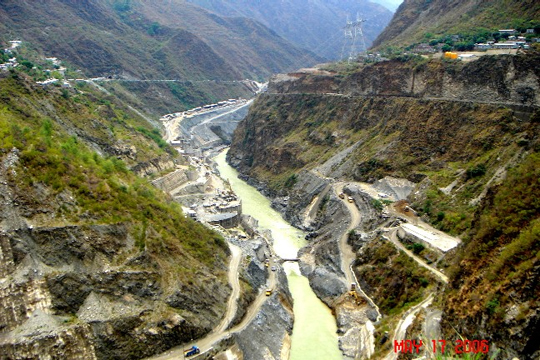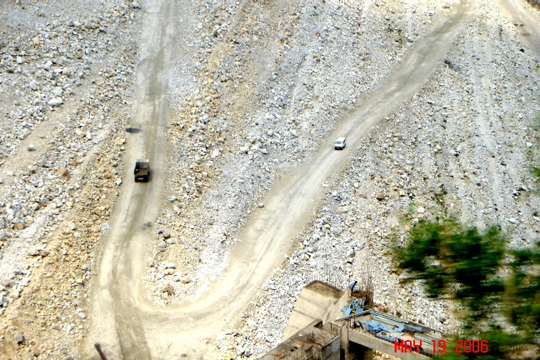On a trail of the Ganga -
PART 1V
-Saraswati Kavula
I told Gyanji Maharaj
that I went to Gomukh and could see no glacier there. Gyanji replied, “You might not have gone beyond the mountain, if you go there, you could see the glacier, I had been there, two days ago”. “Yes, but it was supposed to be on this side of the mountain.
And, I was not in a position to walk any more than that!” Gyanji replied, “Yes, it is true, the Glacier has receded from its original position. I think every year it is receding by 10-20 metres. It is the effect of Global Warming’. I mentioned to him, “I saw
so much trash everywhere, even here in Gangotri and all the way up to Gomukh”. Gyanji replied, “You are right, actually, plastic has reached even up to Tapovan”. He then turned to his visitor and remarked, “Every year, the river cuts through the rocks and
goes deeper into the earth. They say that earlier the river was flowing on top of those ridges, slowly it has cut through the mountains and today it is in this level. The scriptures say that, by the end of Kalyug, Ganga will disappear into Pataal (the earths’
bowels)”. May be that was what’s happening.

I mentioned this issue to a local tour operator, Vijay Semwal. “If our Government has its way, we may not see the Ganga in the near future, when there
is no Ganga, where will the tourists be?” I was a bit surprised, he continued, “See, they had built the Tehri Dam (this dam is about 150 kms down stream on the Ganges) against the advise of many people, today, the reservoir which is 65 kms long, holds 50,000,000
cusecs of water. This is putting a lot of pressure on the already delicate seismic region of the mountains. When this water is going to be released there will be immense pressure and this constant movement of this huge amount of water is going to create trouble.
Now Uttaranchal government is planning 75 Tunnel based Hydro Electric Mini projects of 12 – 20 MW and then there is the Loharnag Mega project of 600 MW. For example just a few kilometres from here, in Gangotri is the place called Bhaironghati, the first Tunnel
based Hydro Project will start there. The Ganga will be diverted through a tunnel, many kilometres away and let out; the force of the water will be used for generating electricity. This will reduce the flow of the water, and we will not be able to see the
River in that area. You can imagine what the effect of the 75 projects will be on this region?’ Vijay Semwal mentioned that while the Uttaranchal government is claiming this is for the development of the region, no local people are being given jobs in these
projects. I mentioned that my brother too is working as an engineer in Kerala, thus a non-local. “See, for specific technical jobs, if they bring outsiders it is fine. But even for jobs like clerks, peons, for administrative jobs too they are taking outsiders.
In Uttaranchal we have nearly 84% literacy. So, it is not as if, there are no educated people here’. That was true, even in remote villages of the Hills; I found that the minimum education of the people was 10+2, if not a bachelor’s degree. “Our youth is going
to the plains looking for jobs, while here they are bringing outsiders, this will surely create problems of regionalism in the future. Already a rift between the locals and non-locals is developing”.
I asked him why the locals were not being employed. “See most of the Contractors are from outside, even your ex-chief minister Chandrababu Naidu’s brother
is one of them. Our people are very aware, and of course they have strong unions too. They feel that if they take local people, they might form unions and become a strong force, and even help the anti-dam activists. So, they are bringing their own people to
work here.’ I guess as non-locals, in a strange place, people will be less inclined to speak out against the policies of a company. “Tehri Dam was under the government undertaking, there fore, many local people got jobs, but all these
new projects are being given to private companies. Can’t say what the future will be like here! Even jobs like drivers are being given to non-locals who come from Bihar, Orissa, Bengal, Rajasthan, UP and Andhra. Tomorrow I might have to come to Hyderabad looking
for work!’ This reminded me my mother’s words, who is always complaining that the city is getting congested since people from all over India are landing in Hyderabad.
‘It is crazy’, continued Vijay. ‘When Uttaranchal was a part of Uttar Pradesh, these 75 Hydro electric Projects were given
to companies from other states and some foreign companies, and the UP State has taken the revenue as lease amount. For example, the 11 MW Phalinda Dam, was leased in 1994 December to Chandra babu Naidu’s brother’s company Swastik Constructions for a period
of 40 years. Later when the state got separated from Uttar Pradesh, they demanded Swastik to pay the fees of Rs. 2 Crores. Swastik said that since they had already paid that amount to the UP government, they don’t have to pay once again. So, Uttaranchal Government
said, “you increase the capacity of the project for 22 MW, and pay us Rs.2 Crores as part of our share of the fees.’

‘You see the problem with these tunnel based projects is – there is no displacement, hence no compensation, but the local
people will lose the water from the river with which they are irrigating their lands. For example, on the banks of Bhilangana, five villages irrigate their lands from the river water. Once the water gets diverted through a tunnel, these villages will hardly
have any water left for their use. And the Government is not paying any compensation, since there is no displacement. While in Loharnag Project (600MW) which is being undertaken by the NTPC, nearly 150 villages are being affected. No rehabilitation has happened
so far. Under Tehri, nearly 170 villages got displaced, rehabilitation and compensation happened, to what ever extent, but it took place, but here, no such thing is even being talked about.’
I asked Vijay if there was a way of developing eco-tourism the way it is in some villages of Goa, where people stay as house guests with the locals and
eat local food and walk or use available transport. ‘In Goa it may be possible, but here, people are too rigid in their traditions. When you stay with a Goanese family, they will offer you a drink on arrival. Here we cannot hope for such a thing. People are
very casteist, and wouldn’t accept outsiders as house guests. We will have to build cottages in local style, that blends with the local environment and organise home stay kind of boarding, serving local food and employing local people. It requires a lot of
money, but governments don’t think of such things. It is a pity!’
( Photo Credits: Kishan Rao; Remodelled Mountains and Blast Area)
To be Continued